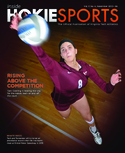The compliance corner answers questions concerning the governance of intercollegiate athletics and its impact on our athletics department. Have a question? Please send it to inside@hokiesports.com and we’ll answer it in upcoming issues.
Now, here are a couple of questions that we’ve received from Tech alums and fans over the past few months, with responses from Tim Parker, Associate AD for Compliance & Governance:
Q: When can a high school prospect start taking official visits? Thanks, Heather in Blacksburg.
TP: “Prospective student-athletes in all sports except basketball cannot take an ‘official visit’ (a visit for which the recruiting school pays some or all expenses) until the opening day of classes during their senior year in high school. In men’s basketball, though, prospective student-athletes can start taking official visits after Jan. 1 of their junior year. In women’s basketball, prospective student-athletes cannot take official visits until the Thursday after the NCAA Division I women’s basketball national championship game during their junior year of high school.
“Rules allowing for earlier official visits in men’s and women’s basketball were adopted in an attempt to emphasize relationship-building between college coaches and prospects, while also limiting the influence of third parties (specifically, shady AAU coaches) on the recruiting process.”
Q: I read recently where the NCAA is going to allow midyear enrollees to sign a letter of intent in August. Is this true, and is this the beginning of any early signing period for all of college football? Thanks, Danny in Blacksburg.
TP: “You’re only partly right. The NCAA made a new rules interpretation that allows student-athletes who plan to enroll at an institution in January of their senior year of high school to sign a financial aid agreement with the school as early as Aug. 1. They are not signing a letter of intent. Also, keep in mind that this is for all sports, and not just football.
“This interpretation gives many coaches some of what they wanted. They get unlimited communication with a prospect once he or she signs the financial aid agreement. However, this does not bind the prospect to the university. He or she still has the freedom to make a different choice.
“The American Football Coaches Association has long pushed for an NCAA regulation that would establish an early signing period for football to reduce some of the recruiting madness. But there are drawbacks. A lot of coaches do not like to juggle official visits with games and prefer to bring prospects in for official visits in December and January, which allows them to spend more time with the prospect. Also, what if a prospect signs early and then the coach leaves his school? What happens then? And many coaches want to see a prospect’s first-semester senior-year grades before going deeper into the process.
“So there are a lot of variables to work through in creating an early signing period for football. An NCAA football recruiting subcommittee is looking at the issue, but there is no timetable set to reach a final decision.”
Q: Why did it take so long for the NCAA to rule on Miami’s violations? It was nearly three years ago when the NCAA started investigating. That just seems ridiculous. Best wishes, Carl in Roanoke.
TP: “It did take a long time, but this was a fairly complicated case with multiple parties involved. In fact, it’s probably the most complex case in NCAA history. Factor in that the NCAA made some missteps in the gathering of some information, and you have the makings for a long process.
“One must also remember that this Committee on Infractions is filled with volunteers, which means they have to find agreeable dates to meet and then put together a long report. That isn’t always easy. These people have day jobs and summer vacations, and things of that sort, just like us ‘normal’ people.
“Miami had its hearing with the Committee on Infractions in June – four months ago – and usually it takes an average of 3.5 months for that committee to make a ruling, again depending on the complexities of the case. USC waited four months to hear back from the COI on the Reggie Bush case in 2010, and Indiana actually waited five months to hear back on the Kelvin Sampson case in 2008.
“Miami was put on three years probation. The biggest penalty came in the form of lost scholarships. The Hurricanes will lose nine football scholarships for the next three years and three men’s basketball scholarships.”




